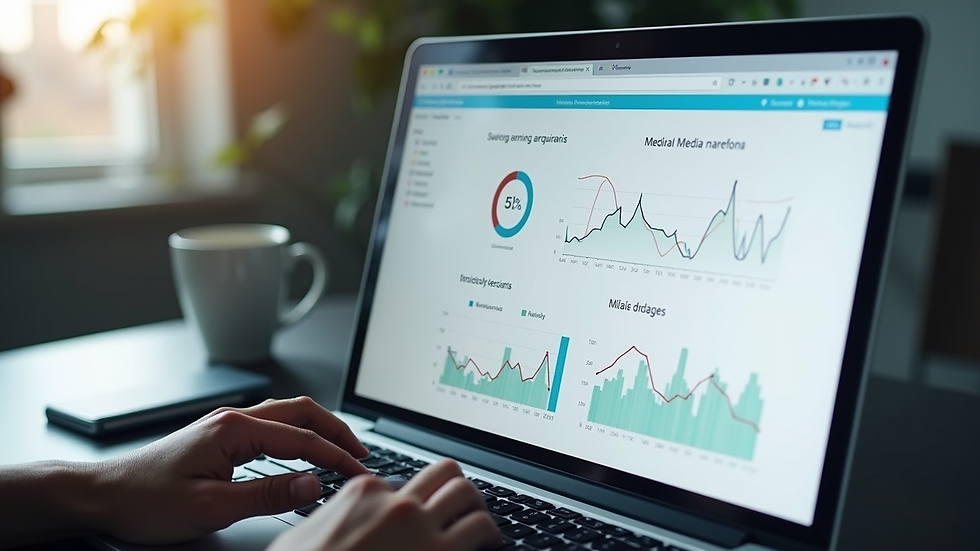Conducting a Digital Media Audit for Your Business
- Redic Grant
- Oct 25
- 5 min read
In today’s fast-paced digital world, keeping your business’s online presence sharp and effective is like tuning a high-performance engine. Without regular check-ups, even the best machines lose their edge. That’s where a digital media audit comes in. It’s the diagnostic tool that helps you understand what’s working, what’s not, and where to steer your efforts next. If you want to scale your business to six active clients by December 2025, this audit is your roadmap.
Why Digital Media Strategies Matter for Your Business Growth
Digital media strategies are the backbone of any successful marketing plan. They help you connect with your audience, build brand awareness, and ultimately drive sales. But crafting these strategies without a clear understanding of your current digital footprint is like setting sail without a compass.
When I talk about digital media strategies, I’m referring to the deliberate plans you put in place across platforms like social media, email marketing, your website, and paid advertising. These strategies should align with your business goals and be flexible enough to adapt as trends and technologies evolve.
For example, if your Instagram engagement is high but your website traffic is low, your strategy might need to focus more on converting social followers into website visitors. Or, if your email open rates are dropping, it might be time to refresh your content or segment your lists better.
Key components of effective digital media strategies include:
Clear goals aligned with business objectives
Consistent brand messaging across channels
Data-driven decision making
Regular performance reviews and adjustments

How to Conduct a Digital Media Audit: Step-by-Step Guide
Conducting a digital media audit might sound intimidating, but breaking it down into manageable steps makes it straightforward. Think of it as spring cleaning for your online presence. Here’s how I approach it:
1. Inventory Your Digital Assets
Start by listing all your digital channels and assets. This includes:
Website and landing pages
Social media profiles (Facebook, Instagram, LinkedIn, Twitter, etc.)
Email marketing platforms
Paid advertising accounts (Google Ads, Facebook Ads)
Content assets like blogs, videos, and infographics
Knowing what you have is the first step to understanding how well each piece fits into your overall strategy.
2. Analyze Performance Metrics
Next, dive into the data. Use tools like Google Analytics, social media insights, and email marketing reports to gather key metrics such as:
Website traffic and bounce rates
Social media engagement (likes, shares, comments)
Conversion rates and lead generation
Email open and click-through rates
ROI on paid campaigns
Look for patterns and anomalies. For instance, a high bounce rate on your website might indicate poor user experience or irrelevant content.
3. Evaluate Content Quality and Consistency
Review your content across all platforms. Is your messaging consistent? Does your content reflect your brand voice and values? Are you providing value to your audience or just pushing sales?
High-quality content builds trust and keeps your audience coming back. If your posts feel stale or disconnected, it’s time to refresh your approach.
4. Assess Competitor Presence
Understanding where you stand in your market is crucial. Analyze your competitors’ digital presence:
What platforms are they active on?
What type of content do they produce?
How engaged is their audience?
What keywords are they targeting?
This competitive insight can reveal opportunities and gaps in your own strategy.
5. Identify Gaps and Opportunities
Finally, summarize your findings. Highlight what’s working well and where improvements are needed. This might include:
Underutilized platforms
Content topics that resonate more
Technical issues like slow website speed
Opportunities for paid advertising or influencer partnerships
This step sets the stage for actionable changes that will boost your digital presence.

What are the 4 Types of Audit?
Audits come in different flavors, each focusing on a specific aspect of your digital presence. Understanding these types helps you tailor your approach.
1. Content Audit
This audit reviews all your content assets to evaluate quality, relevance, and performance. It answers questions like:
Which blog posts drive the most traffic?
Are videos engaging your audience?
Is your content aligned with your brand voice?
2. Social Media Audit
Here, you analyze your social media profiles and activity. Key points include:
Follower growth and engagement rates
Posting frequency and timing
Platform-specific performance
Competitor social media strategies
3. SEO Audit
Search engine optimization is critical for organic visibility. An SEO audit checks:
Website structure and navigation
Keyword usage and rankings
Backlink profile
Technical SEO issues like broken links or slow loading times
4. Paid Media Audit
If you invest in paid advertising, this audit evaluates:
Campaign performance and ROI
Targeting accuracy
Ad creatives and messaging
Budget allocation and spend efficiency
Each audit type provides a unique lens to view your digital health. Combining insights from all four gives you a comprehensive picture.

Turning Audit Insights into Actionable Digital Media Strategies
Once you’ve completed your audit, the real work begins - turning insights into action. Here’s how I recommend moving forward:
Prioritize Based on Impact and Effort
Not all changes are created equal. Use a simple matrix to prioritize:
High impact, low effort: Fix these first (e.g., updating website meta tags)
High impact, high effort: Plan these carefully (e.g., redesigning your website)
Low impact, low effort: Do if time allows (e.g., tweaking social media bios)
Low impact, high effort: Usually avoid or delegate
Set Clear, Measurable Goals
Translate audit findings into specific goals. For example:
Increase website traffic by 20% in 6 months
Boost Instagram engagement rate by 15% by next quarter
Improve email open rates by 10% within 3 months
Develop a Content Calendar
Consistency is key. Plan your content around themes that resonate with your audience and support your goals. Include:
Blog posts
Social media updates
Email newsletters
Paid ad campaigns
Optimize Your Website and SEO
Address technical issues uncovered in the audit. Improve site speed, fix broken links, and optimize for mobile. Refresh keywords and meta descriptions to boost search rankings.
Monitor and Adjust Regularly
A digital media audit is not a one-time event. Schedule quarterly or bi-annual audits to keep your strategies aligned with changing trends and business goals.
Embracing the Power of a Digital Media Audit for Sustainable Growth
Scaling your business to six active clients by December 2025 is an ambitious but achievable goal. A digital media audit is the foundation that will support this growth. It’s like tuning your engine before a long race - ensuring every part is working efficiently and ready to perform.
By regularly assessing your digital presence, you gain clarity and control. You’ll know exactly where to invest your time and resources for the best return. Plus, you’ll be better equipped to adapt to the ever-changing digital landscape.
Remember, digital media strategies are not static. They evolve as your business grows and as your audience’s needs shift. The audit keeps you on track, helping you make informed decisions that drive real results.
So, roll up your sleeves and start your digital media audit today. Your future clients are waiting to discover what your business has to offer.






Comments